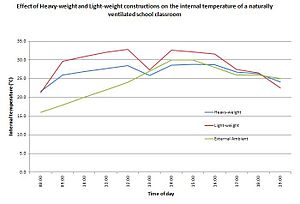This article includes a list of general references, but it lacks sufficient corresponding inline citations. (September 2017) |

In building design, thermal mass is a property of the matter of a building that requires a flow of heat in order for it to change temperature. In scientific writing the term "heat capacity" is preferred. It is sometimes known as the thermal flywheel effect.[1] The thermal mass of heavy structural elements can be designed to work alongside a construction's lighter thermal resistance components to create energy efficient buildings.
For example, when outside temperatures are fluctuating throughout the day, a large thermal mass within the insulated portion of a house can serve to "flatten out" the daily temperature fluctuations, since the thermal mass will absorb thermal energy when the surroundings are higher in temperature than the mass, and give thermal energy back when the surroundings are cooler, without reaching thermal equilibrium. This is distinct from a material's insulative value, which reduces a building's thermal conductivity, allowing it to be heated or cooled relatively separately from the outside, or even just retain the occupants' thermal energy longer.
Scientifically, thermal mass is equivalent to thermal capacity or heat capacity, the ability of a body to store thermal energy. It is typically referred to by the symbol Cth, and its SI unit is J/K or J/°C (which are equivalent). Thermal mass may also be used for bodies of water, machines or machine parts, living things, or any other structure or body in engineering or biology. In those contexts, the term "heat capacity" is typically used instead.
- ^ Principles of eco-design Archived 2005-04-04 at the Wayback Machine